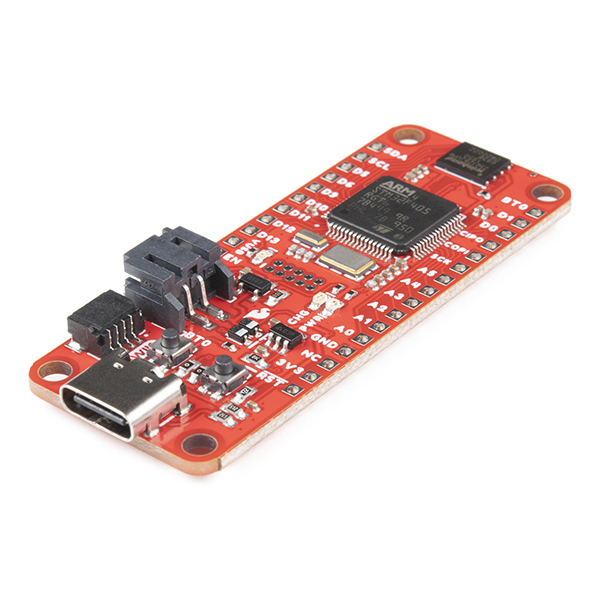SparkFun Thing Plus - STM32
With a 32-bit ARM® Cortex®-M4 RISC core, the SparkFun STM32 Thing Plus brings power and precision to your projects. The STM32 Thing Plus provides you with an economical and easy to use development platform if you're needing more power with a minimal working space. This Thing comes flashed with the DFU bootloader, and to make the Thing Plus even easier to use, we've moved a few pins around to make the board Feather compatible. In addition, it utilizes our handy Qwiic Connect System which means no soldering or shields are required to connect it to the rest of your system!
As we previously stated; the STM32F405 Processor is based on the high-performance ARM® Cortex®-M4 32-bit RISC core and can operate at a frequency of up to 168 MHz. The Cortex-M4 core features a floating point unit (FPU) single precision which supports all ARM single precision data-processing instructions and data types. It also implements a full set of DSP instructions and a memory protection unit (MPU) which enhances application security. This Processor Board utilizes the DFU bootloader for uploading code, and incorporates an extensive range of enhanced I/Os and peripherals. In addition to the USB interface and Qwiic connection, the STM32 Thing Plus provides a 3.3V regulator and LiPo charger as well as 16MB of Flash and microSD slot for expandable memory.
The SparkFun Qwiic Connect System is an ecosystem of I2C sensors, actuators, shields and cables that make prototyping faster and less prone to error. All Qwiic-enabled boards use a common 1mm pitch, 4-pin JST connector. This reduces the amount of required PCB space, and polarized connections mean you can’t hook it up wrong.
STM32 General Features:
- ARM® 32-bit Cortex®-M4 CPU with FPU
- Adaptive real-time accelerator (ART Accelerator™) allowing 0-wait state execution from Flash memory
- Frequency up to 168 MHz
- Memory protection unit
- 210 DMIPS/ 1.25 DMIPS/MHz (Dhrystone 2.1)
- DSP instructions
- 1 Mbyte of Flash memory
- 192 Kbytes of SRAM including 64 Kbytes of CCM (core coupled memory) data RAM
- Flexible static memory controller supporting Compact Flash, SRAM, PSRAM, NOR and NAND memories
- Clock, reset and supply management
- 1.8 V to 3.6 V application supply and I/Os
- 32 kHz oscillator for RTC with calibration
- Internal 32 kHz RC with calibration
- Low-power operation
- Sleep, Stop and Standby modes
- VBAT supply for RTC, 20×32 bit backup registers + optional 4 KB backup SRAM
- Debug mode
- Serial wire debug (SWD) & JTAG interfaces
- Cortex-M4 Embedded Trace Macrocell™
- Advanced connectivity
- USB 2.0 full-speed device/host/OTG controller with on-chip PHY
- USB 2.0 high-speed/full-speed device/host/OTG controller with dedicated DMA, on-chip full-speed PHY and ULPI
- 10/100 Ethernet MAC with dedicated DMA: supports IEEE 1588v2 hardware, MII/RMII
Specific Peripherals available on STM32 Thing Plus:
- UART bus
- I2C Bus
- SPI bus
- Up to 15 Analog Inputs, Two Analog Outputs
- 20 Digital I/O Pins, 14 PWM Capable
- SDIO for microSD card support
- JTAG Serial Wire Debug Support
- Power Select
- LiPo Charging Circuit
- 3.3V Regulator
- 128 Mbit SPI Flash
SparkFun Thing Plus - STM32 Product Help and Resources
SparkFun Qwiic Shield for Thing Plus Hookup Guide
January 30, 2020
A short guide for assembling and using the SparkFun Qwiic Shield for Thing Plus.
Core Skill: Programming
If a board needs code or communicates somehow, you're going to need to know how to program or interface with it. The programming skill is all about communication and code.
Skill Level: Rookie - You will need a better fundamental understand of what code is, and how it works. You will be using beginner-level software and development tools like Arduino. You will be dealing directly with code, but numerous examples and libraries are available. Sensors or shields will communicate with serial or TTL.
See all skill levels
Core Skill: Electrical Prototyping
If it requires power, you need to know how much, what all the pins do, and how to hook it up. You may need to reference datasheets, schematics, and know the ins and outs of electronics.
Skill Level: Rookie - You may be required to know a bit more about the component, such as orientation, or how to hook it up, in addition to power requirements. You will need to understand polarized components.
See all skill levels
Comments
Looking for answers to technical questions?
We welcome your comments and suggestions below. However, if you are looking for solutions to technical questions please see our Technical Assistance page.
Customer Reviews
5 out of 5
Based on 1 ratings:
I like the Thing Plus Line
This is one of several Thing Plus controllers I have purchased. they give me all the sub-modules I normally need on one board : ) Micropython boots up, and runs fast




